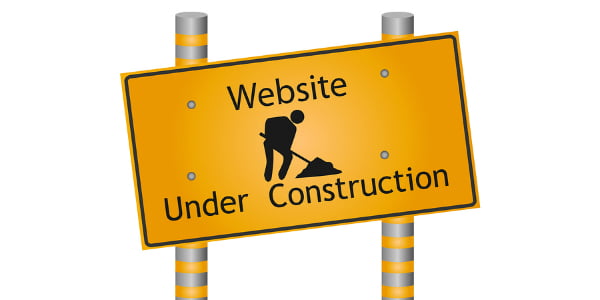Your credit union website is not a billboard

We have seen a vast number of new credit union websites launch over the past year.
And they look great! So much better than they did before.
Some of these even use a responsive layout and user interface to provide the most optimal experience based upon a user’s device, such as desktop, mobile phone or tablet.
But looks are only skin deep.
Instead of building a website that sells, most of the new designs are nothing more than a fresh coat of paint on an old, tired structure.
What’s the Point of Your Website?
Your website ultimately has two goals.
1. Help consumers. Whether its for them to access their online accounts, apply for loans or learn about new products, services and events, consumers are looking for you to keep things as simple as possible.
2. Become your number one sales channel. You are looking to generate leads, increase conversions and grow share of wallet through your digital branch.
To achieve the second goal, a new approach must be taken. And this concept will directly impact the first goal.
It will also change the way you approach website RFPs.
One Way You Can Drastically Improve Your Website Today
Regardless of if you just developed a new website or have one that is a couple of years old, take a look at your home page.
What do you see?
How many web banners, promos and calls to actions do you have?
Go ahead. Count them up.
Odds are, the older your website is, the more calls to actions you have. This probably is a result of different departments requesting new items to be placed on the home page for their own agendas and goals
Now consider what you want someone to do when they visit your website.
That’s difficult to answer because it really depends on who they are.
Does this person already have an account? Or are they a first time home buyer? Have they adopted PFM or remote deposit capture? Are they looking to buy a new car? Do others in their household have an account with you?
If you want to drastically improve your website today, remove all the banners on your home page.
Do it.
You may be thinking, “You’re crazy! We are right in the middle of a big loan promotion. How will people learn about it? On top of that, what will we put on our home page? We ALWAYS have something to promote.”
Read on and I will show you a better approach.
Here is Why Your Online Banners Don’t Work
One message. Many people.
This is the basic principle of broadcast marketing.
Radio. TV. Newspaper ads. Billboards.
Think again about your website promos and banners.
If you have more than one major promotion banner, your home page is a digital billboard.
And billboards on your website are wasted space and create virtual noise.
Why?
Because everyone sees the same thing. There is no personalization. There is no context.
What good does showing an auto loan banner for an account holder who already has this type of loan with you?
It’s redundant.
And if your banners or promotions on your website do not provide value to them, you are training them to ignore future website banners and promotions.
One Website Banner is All You Need to Grow
The fewer the options a consumer has, the better.
In the book The Paradox of Choice, author Barry Schwartz argues that eliminating consumer choices greatly reduces anxiety for shoppers. A reduction of choices can have a positive impact on helping consumers make purchase decisions. And as a result, sales increase.
While this idea may be counterintuitive and may be a hard sell to your executive team, there is another reason to reduce the number of website banners and promotions to one.
Oftentimes, credit unions use a rotating banner carousel to display multiple web banners. Sometimes these banners auto rotate. Othertimes, a user can control the progression of these banners.
Either way, this tactic does not work.
And there are two ways to prove this.
One is to look at your website analytics and explore the digital behavior of website visitors.
The second is to look at research from a web usability study performed by Notre Dame University. In this study, they found that approximately 1% of all visitors to their website clicked on a featured web banner promotion. Of these clicks, 84% were on the first web banner. The remaining 16% were split fairly evenly between the other four web banners.
It’s telling evidence of user behavior.
A Better Approach Website Banners
As I have written about before, financial products and services have become commoditized.
One way to differentiate yourself from other financial institutions is to employ helpology. Helpology is the combination of technology, content and context to provide proactive help and educational insight to consumers. And it doesn’t matter where they are in the buying process.
You can replace your rotating web banner carousel and other promotions cluttering your home page with a single banner that is personalized for each website visitor.
Marketing automation platform Marketo reported marketers can drive up to a 30% increase in conversion rates and up to a 270% increase in content consumption by using firmographic and behavioral data to customize web and mobile experiences.
Here are a few ways to use the single web banner.
- Digital behavior: Show one web banner on your home page based upon the specific pages a consumer viewed on their last visit. For example, if they visited the mortgage section, the web banner would be tailored to promote mortgages. This banner could also be further customized depending on where they are in the buying process. Are they a first time home buyer? Or have they been through this process before?
- Transactional behavior: By unifying your website and PFM platform, you can use a single web banner to target specific account holders who may have loans or accounts at other financial institutions. For example, you could target account holders who have an auto loan at Ally Bank with a refinance banner. Or those who incurred an ATM fee at Wells Fargo with a free checking account offer. You could even encourage digital referrals and provide account holders referral incentives based upon their personal spending habits.
- Product adoption: Grow share of wallet and increase product adoption by using a single web banner to cross-sell products an account holder may not have. For example, if an account holder has an auto loan but not the insurance product, display a banner about how much they could save by switching their auto insurance to you.
When you begin to think of all the different ways you can reduce the number of web banners on your home page, it can quickly become overwhelming.
As always, we recommend you start small with this and grow from there.

